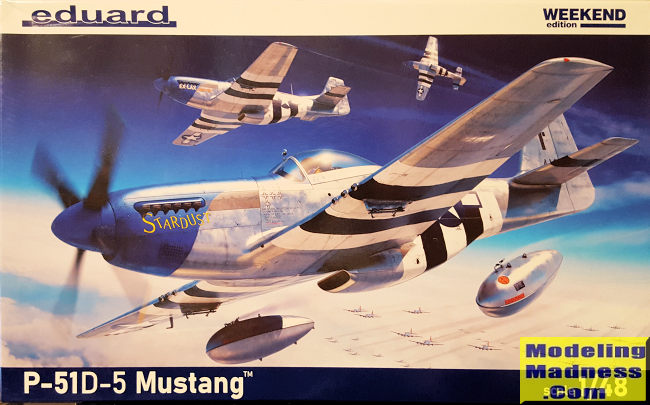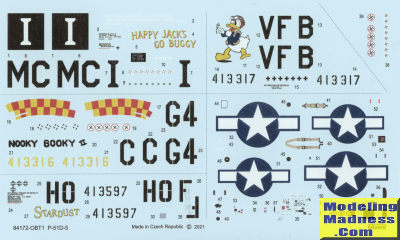
| KIT #: | 84172 |
| PRICE: | $33.84 delivered |
| DECALS: | Four options |
| REVIEWER: | Scott Van Aken |
| NOTES: | 2022 release. Weekend Edition |

| HISTORY |
Following combat experience the P-51D series introduced a "teardrop", or "bubble", canopy to rectify problems with poor visibility to the rear of the aircraft. In America, new moulding techniques had been developed to form streamlined nose transparencies for bombers. North American designed a new streamlined plexiglass canopy for the P-51B which was later developed into the teardrop shaped bubble canopy. In late 1942, the tenth production P-51B-1-NA was removed from the assembly lines. From the windshield aft the fuselage was redesigned by cutting down the rear fuselage formers to the same height as those forward of the cockpit; the new shape faired in to the vertical tail unit. A new simpler style of windscreen, with an angled bullet-resistant windscreen mounted on two flat side pieces improved the forward view while the new canopy resulted in exceptional all-round visibility. Wind tunnel tests of a wooden model confirmed that the aerodynamics were sound.
The new model Mustang also had a redesigned wing; alterations to the undercarriage up-locks and inner-door retracting mechanisms meant that there was an additional fillet added forward of each of the wheel bays, increasing the wing area and creating a distinctive "kink" at the wing root's leading edges.
Other alterations to the wings included new navigation lights, mounted on the wingtips, rather than the smaller lights above and below the wings of the earlier Mustangs, and retractable landing lights which were mounted at the back of the wheel wells; these replaced the lights which had been formerly mounted in the wing leading edges.
The engine was the Packard V-1650-7, a licence-built version of the Rolls-Royce Merlin 60 series, fitted with a two-stage, two-speed supercharger.
The armament was increased with the addition of two more .50 in (12.7 mm) AN/M2 "light-barrel" M2 Browning machine guns, the standard heavy-calibre machine gun used throughout the American air services of World War II, bringing the total to six. The inner pair of machine guns had 400 rounds per gun, and the others had 270 rpg, for a total of 1,880.[38] The B/C subtypes' M2 guns were mounted with an inboard axial tilt, this angled mounting had caused problems with the ammunition feed and with spent casings and links failing to clear the gun-chutes, leading to frequent complaints that the guns jammed during combat maneuvers. The D/K's six M2s were mounted upright, remedying the jamming problems. In addition, the weapons were installed along the line of the wing's dihedral, rather than parallel to the ground line as in the earlier Mustangs.
The wing racks fitted to the P-51D/P-51K series were strengthened and were able to carry up to 1,000 lb (450 kg) of ordnance, although 500 lb (230 kg) bombs were the recommended maximum load. Later models had removable under-wing 'Zero Rail' rocket pylons added to carry up to ten T64 5.0 in (127 mm) HVAR rockets per plane. The gunsight was changed from the N-3B to the N-9 before the introduction in September 1944 of the K-14 or K-14A gyro-computing sight. Apart from these changes, the P-51D and K series retained V-1650-7 engine used in the majority of the P-51B/C series.
The addition of the 85 US gallon (322 l) fuselage fuel tank, coupled with the reduction in area of the new rear fuselage, exacerbated the handling problems already experienced with the B/C series when fitted with the tank, and led to the same fillet being added to -B, -C and initial -D-series versions in the field, to be quickly standardized as a normal rear-fuselage airframe component on later production blocks of the -D version. P-51Ds without fuselage fuel tanks were fitted with either the SCR-522-A or SCR-274-N Command Radio sets and SCR-695-A, or SCR-515 radio transmitters, as well as an AN/APS-13 rear-warning set; P-51Ds and Ks with fuselage tanks used the SCR-522-A and AN/APS-13 only.
| THE KIT |
 Eduard fans have been crowing about how wonderful Eduard's P-51s compared
to the other kits on the market so when I found one at a good price, I picked it
up. This is a weekend edition so no photo etch or canopy masks. No worries on
either as Eduard has learned their lesson about having parts in their weekend
kits that require the absent photo etch. In this case, the instrument panel and
seat harness are provided on the decal sheet as are a variety of placards. No
worries about matching paints.
Eduard fans have been crowing about how wonderful Eduard's P-51s compared
to the other kits on the market so when I found one at a good price, I picked it
up. This is a weekend edition so no photo etch or canopy masks. No worries on
either as Eduard has learned their lesson about having parts in their weekend
kits that require the absent photo etch. In this case, the instrument panel and
seat harness are provided on the decal sheet as are a variety of placards. No
worries about matching paints.
As expected, there are a plethora of fairly small parts, with most of them confined to the cockpit. This takes up most of the first two pages of the instructions with lots of little notes so pay attention when building. The main gear well also contains quite a few parts and while I doubt that most of it was chrome silver as the instructions request, I am sure most of it was aluminum. Eduard is notorious for close tolerances so I recommend studying the instructions and building as much as you can prior to painting.
There were a number of changes in terms of panels between the different variants so you will be required to fill in some areas and do some trimming in others. You will also need to fill in some holes. Once the wing is assembled and attached, you move to the tail. The early D model Mustangs had fabric elevators and rudders so be sure to use those parts and not the metal covered ones.
Landing gear is nicely done and can be installed after the airframe is
painted. Flaps are molded in the lowered position, which is accurate for the
P-51 as they normally slowly extended after the engine was shut down and
hydraulic pressure was lost. Two different exhaust are provided, one without the
manifold shield so pay attention to the markings option you are going to use.
Three props are provided, but you
 want to use the cuffed Hamilton Standard for
this kit. Canopy can be posed open if you wish. Under the wings you have the
choice of two styles of drop tank depending on your marking option.
want to use the cuffed Hamilton Standard for
this kit. Canopy can be posed open if you wish. Under the wings you have the
choice of two styles of drop tank depending on your marking option.
Four markings options are provided. All start with a combination of aluminum lacquer and bare aluminum. Three of them have D-Day stripes under the wing and fuselage while two have an RAF green on much of the upper surfaces. Decals are nicely printed and you get a full stencil suite. A full page of the instructions is dedicated to stencils. There are several aftermarket sheets that have early Ds on it if you don't like what is being offered in the kit.

| CONCLUSIONS |
It is said that this is the most accurate 1/48 Mustang yet available. It certainly has more parts than the other kits. My experience with Eduard kits is that while they certainly put the effort towards being the most accurate, they are fiddly and sometimes frustrating builds. It will be interesting to see how this one goes.
| REFERENCES |
https://en.wikipedia.org/wiki/North_American_P-51_Mustang_variants#P-51D_and_P-51K
August 2022 Copyright ModelingMadness.com. All rights reserved. No
reproduction in part or in whole without express permission from the editor.
If you would like your product reviewed fairly and fairly quickly, please
contact the editor
or see other details in the
Note to
Contributors.